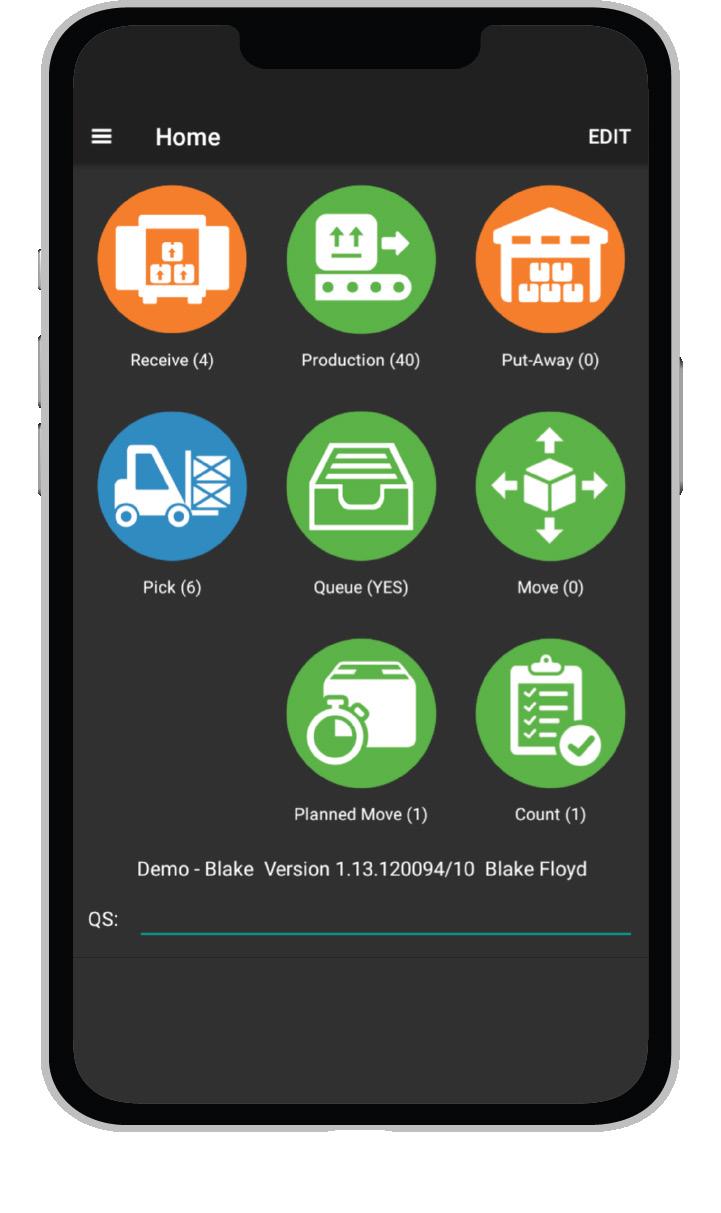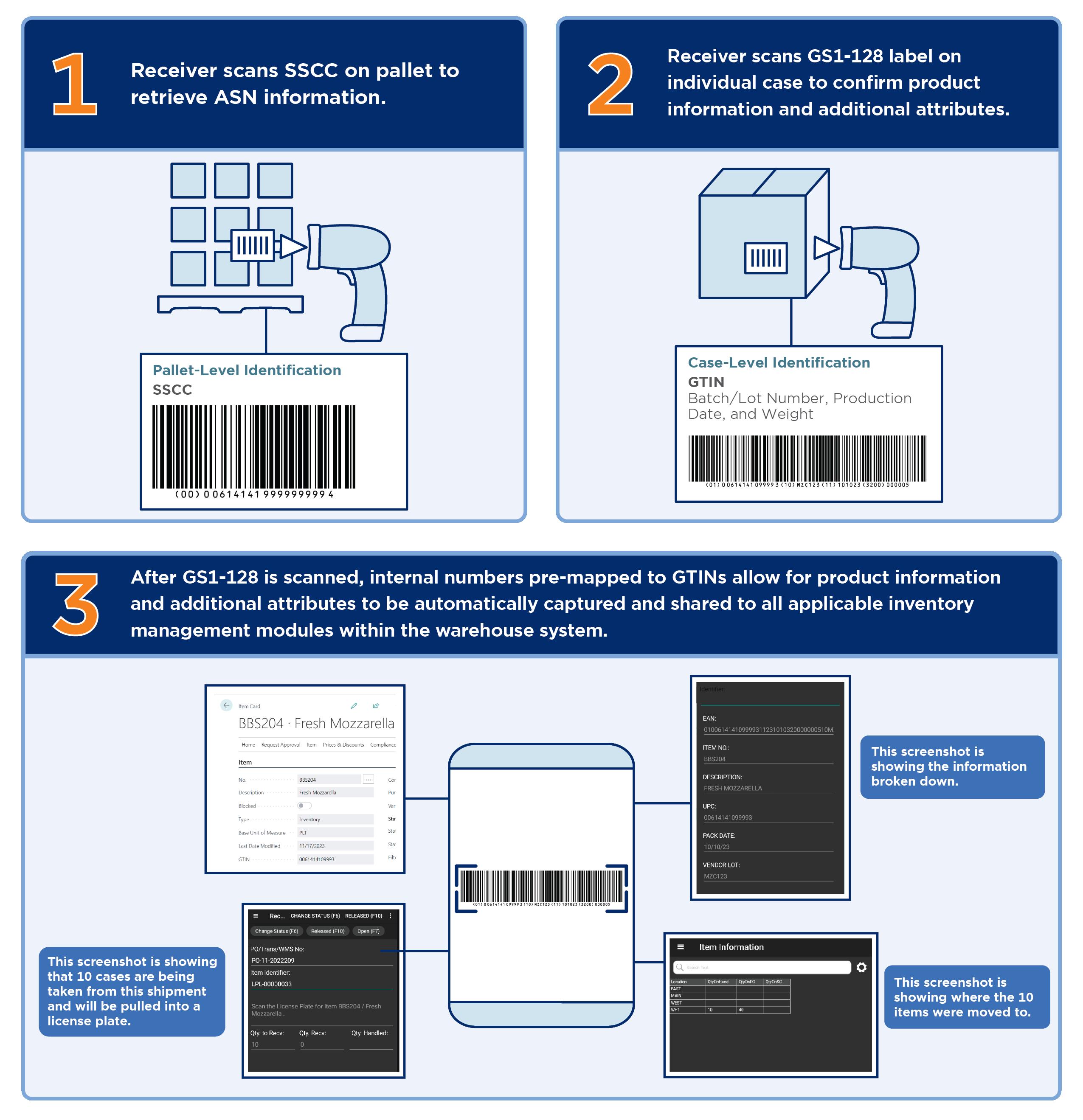
Overview
Consumer and regulatory demands are putting pressures on growers, processors, manufacturers, and distributors. Being able to trace food from farm to table has become an integral part of the supply chain, especially now with the additional traceability requirements of Section 204(d) of the Food Safety Modernization Act (FSMA), better known as the Food Traceability Final Rule. And foundation to support the U.S. FDA New Era of Smarter Food Safety Blueprint.
This level of traceability and visibility is only possible with global standards for unique identification of the product, lot, and source/supplier. The Global Trade Item Number® (GTIN®) is widely used in supply chains around the globe to identify unique products—but for the food supply chain, its full value is yet to be unlocked.
The use of legacy Enterprise Resource Planning systems (ERPs) and the limited functionality to utilize (or scan) and transact with them is causing GTINs to get “dropped” from the electronic data flow after products leave growers, processors, or manufacturers. When an “item” is received from the supplier, it is associated with an internal product code, and the GTIN gets dropped at the receiving dock. The internal product code and internal lot number now become the sole identifiers of the product received, losing the specific attributes needed for traceability and visibility across the farm-to-fork supply chain.
This whitepaper will explore the benefits of GTINs for realtime visibility of product flow across the food supply chain, and how, with capabilities in food and beverage industryspecific ERP solutions, GTINs can be mapped to internal product codes for improved operating efficiencies and regulatory requirements.
Introduction to the GS1 System of Standards
The GS1 System of Standards can raise the efficiency and accuracy of business processes, resulting in cost savings through automation based on globally unique identification and digital information. GS1 Standards provide unique identification keys to identify goods, services, assets, and locations worldwide.
These keys can be represented in data carriers, such as GS1-128 and UPC barcodes, to enable automatic data capture. The information within these data carriers can enable end-to-end traceability.
End-to-end traceability is achieved when trading partners effectively implement processes that enable each supply chain partner to identify the source of a product and its recipients. Implementing a global traceability system across the supply chain entails partners linking the physical flow of products with the flow of information about them.
Standards are essential to this effort because they provide a common language that helps enable trading partners to communicate with each other and their ERP solutions to process and manage the data they exchange.
ERPs that support GS1 Standards can overcome the limitations of using company-, organization-, or sectorspecific technology. GS1 Standards enable large-scale deployment and flexibility in the selection of the most suitable system components—ultimately making the information in ERP solutions much more efficient and accurate.


The Basics of Mapping and Parsing a GTIN Producers, processors, and manufacturers typically use their own in-house numbering systems to identify their produced products, raw materials, and packaging. The key to maintaining traceability data is to link GTINs to all internal product codes.
Imagine a scenario where a processor sources tomatoes from multiple suppliers. Each supplier has their own item number (and possibly GTIN) for tomatoes. If the supplier happens to be a distributor selling tomatoes from multiple sources, there may be multiple GTINs (a unique GTIN from each farm) for the distributor’s tomatoes. If there is no standardized logic built into the item number, trading partners may struggle to track and transact on those products in an efficient manner.
GTIN mapping is the process of associating a GTIN with the relevant data for the product that the GTIN identifies. Utilizing GTIN mapping allows the business to create a many-to-one relationship for item numbers by using a predefined global standard. Food and beverage industry-specific ERP systems can map or define the relationship between one or multiple GTINs and their internal product identifier.
Before you can begin mapping GTINs, there are some important basics to understand regarding how GTINs are structured and how they can be utilized to provide additional important information.

GTINs are comprised of a unique GS1 Company Prefix and a unique item reference number, plus a check digit. The company prefix is issued by GS1®, while the item reference number is assigned by the party responsible for creating the GTIN. (In many instances, the item reference number is the company’s internal item number, but it’s not required.)

GTINs can be encoded in a barcode with GS1 Application Identifiers (AIs) to provide additional product information. More on these important GS1 AIs, including the invaluable traceability data they convey, will be covered in this document.

The GS1-128 barcode is commonly used for lotcontrolled products with expiration dates in general distribution and logistics applications. It encodes the GTIN, but what makes it unique from other linear barcodes is its ability to carry attribute data about a product, such as best-before date, batch/lot number, quantity, weight, and many other attributes.

The Serialized Shipping Container Code (SSCC) is the identifier of a pallet or shipping container. Each SSCC is unique, and a single shipment could contain multiple containers, each with their own SSCC. The containers typically bear one or more GS1-128 barcodes.
When businesses utilize GTINs and GS1-128 barcodes with application identifiers (AIs), the ERP system can then parse the information contained in the barcode to streamline transactions and ensure data accuracy.
The food industry has a requirement to collect critical traceability and product information. By mapping GTINs and utilizing the GS1-128 barcoding standard with GS1 AIs, food and beverage businesses can identify and collect important product information.
Encoding this information in the GS1 barcode allows for accurate and streamlined data collection, increased adherence to food safety procedures, and effective and rapid response to recalls if the need arises.

The value of using the GTIN can be realized by imagining the typical product flow in food manufacturing. When a supplier provides a product without a GTIN, your business must manually record all relevant supplier product information and typically create an internal label, which could lack the detailed information that can be included in the GS1-128 barcode.
Collecting and recording the supplier information manually represents a suboptimal use of human resources and the opportunity for human error in data entry.
Additional Context on GTINs in the Food and Beverage Industry Related to Food Safety
The GTIN is gaining broad adoption by food and beverage processors, manufacturers, and distributors. In the fresh produce sector, products go from the farm to the packing house, where products are typically labeled before the goods move on to the distributor, processor, or manufacturer. Recent large-scale food safety-related recalls have led to the creation of the Produce Traceability Initiative (PTI). The goal of the PTI is to create a systematic, industrywide approach to enhance overall supply chain traceability in speed and efficiency. Utilizing the GTIN ensures suppliers are compliant with the requirements of the PTI.
GS1 Standards and identification systems are also very relevant in the dairy, meat, poultry, and seafood industries— among others—due to the variable weight of their products, commonly referred to as “catch weight.” Variable weights can be relayed via GS1 AIs, making it the preferred methodology within businesses in these sectors.
For catch-weight items, the GS1-128 barcode will contain serialized-case AIs. Currently this is only commonly used for catch-weight items, but as regulations and customer requirements evolve, the tracking of serialized cases for all items may become more widespread.
December 2022 brought a change to regulatory compliance requirements for food and beverage businesses in the form of the official publication of the U.S. FDA Food Traceability Final Rule.
While the U.S. FDA is approaching enforcement with a goal to “educate while they regulate,” the compliance date of January 20, 2026, will be here sooner than we think. The 2026 enforcement date is prompting many companies to look ahead to what steps they’ll need to take to ensure adherence to the new regulations.
Those include additional recordkeeping requirements— namely, the tracking of Key Data Elements (KDEs) at all Critical Tracking Events (CTEs)—for products containing any ingredients falling into the 16 categories on the Food Traceability List (FTL). Thankfully, GTIN mapping and use of an ERP solution that can store and trace data contained in GS1-128 barcodes can make compliance with the updated standards a simpler matter.
GS1 has confirmed that the GS1 Application Identifier for batch or lot number, AI (10), can be used as the traceability lot code that the Food Traceability Final Rule requires for items including ingredients on the FTL. What’s more, GTINs can be linked to KDEs—like country of origin and date of production—where they are recorded and transacted against in your ERP solution, which captures the information from the GS1-128 barcode.
Lastly, it’s worth noting that GTINs with batch or lot number AIs can also be included in Advanced Shipping Notices (ASNs) to provide the receiving company with that critical information for Food Traceability Final Rule compliance before the shipment is even received.
That means that by working with both your suppliers and customers to ensure that this information is included, your business and all the trading partners in your supply chain can be confident that all elements of the new requirements are satisfied.
Barcode Scanning and GTINs
Barcode scanning as a means of automating the collection of product, lot, and pallet data has become quite prevalent in the food and beverage industry, as it allows businesses to operate more efficiently, especially in the functional areas of inventory management and traceability.
By fully digitizing the process and eliminating pen-and-paper recordkeeping in favor of a fully automated scan, push of a button, or pull of a trigger, companies that leverage barcode scanning can also boost accuracy and reduce the risk of human error. Additionally, this method allows for real-time collection of data, ensuring data is timely.
To utilize barcode scanning with GTIN information, it’s ideal to have industry-specific ERP software that is integrated with handheld scanners and designed to parse the information in the AIs and record the information contained in the AIs’ correct fields.
Legacy Systems vs. “Next-Gen” ERPs
Manufacturers utilizing legacy systems—which would include older, generic ERPs, in-house solutions, spreadsheets, or pen-and-paper records—are missing out on the opportunities offered with GTIN mapping and scanning.
Generic ERPs are unlikely to have the necessary functionality to map GTINs to your in-house numbering system or parse AIs. This means that barcode scanners integrated with such systems may be unable to scan GTINs and any GS1 AIs to pass that information to the ERP system.
It’s true that generic ERPs can be customized according to the needs of food and beverage companies. Customizations can give those organizations the capability to accommodate AIs and the information they convey.

However, such customizations can be expensive and don’t always carry over with system updates. Customizations may need to be changed when new regulations are passed, and each layer of customization will typically lead to increased costs throughout the life of an ERP system.
Choosing an ERP that was developed from the ground up for food and beverage companies with their unique challenges and specialized processes in mind allows manufacturers to avoid costly customizations and upgrade costs. Modern ERP systems are ready to handle GTIN mapping and GS1 Application Identifier parsing using the system as it is, “out of the box.”
Industry-specific ERPs that are integrated with barcode scanners also form the basis of a “full traceability” approach to food and beverage operations. In terms of hardware requirements for such a setup, you’ll need compatible scanners.
Cloud implementations of ERP solutions are increasingly popular. Organizations are choosing cloud-based ERP because it offers scalability on demand, broader accessibility, enhanced data protection, and integrated cybersecurity. As a deployment method, the cloud offers greater flexibility and reliability, which are key in the food and beverage industry.
The Benefits of Using an ERP to Map and Parse GTINs
Food and beverage businesses use their own internal codes to manage their inventory, though these will not be compatible all along the supply chain. To link GTINs to those codes, they need industry-specific ERP software with technology designed for that purpose.
The main benefit of this practice is to simplify the receiving and verification processes. Using GTINs also simplifies the ordering process, as the numbers serve as a “common language” between suppliers, manufacturers, distributors, retailers, and foodservice operators.
Beyond that, scanning GTINs with handheld barcode scanners can increase your business’s operational efficiency, especially in receiving, processing, and dispatching orders. An ERP designed specifically for food and beverage companies can receive the information captured by the scan and automatically parse it to record the important traceability and food safety data encoded in GTINs.

It’s also important to note that just as food and beverage processors, manufacturers, and distributors rely on their suppliers to provide GS1-128 barcodes, their downstream customers have this same expectation.
Lastly, for distributors, using an ERP solution that can accommodate GTINs allows for a single scan at receipt, and the same identifier can be used throughout all internal processes. Then, when the item is sold and prepared to ship to the customer, all that’s necessary is a single scan and it’s on its way.
Using GTIN Mapping for Transactions
Assuming your organization has the right industry-specific software to accommodate it, GTIN mapping can be utilized to streamline just about any kind of transaction along the supply chain, from receipt and counting to processing and sales. It also provides more visibility into critical traceability elements at every point in your products’ journeys.

Using GS1-128 barcodes and the information encoded therein, you can collect more information and have a more complete picture of your products and their journey from one end of the supply chain to the other. That’s due to the fact that when AIs are added to GTINs, they can convey critical product specifications about consumption, pricing, origin, destination, and more.
For manufacturers and processors, a supplier’s GTIN can be mapped to your internal item number and used for a product until it is processed or consumed in manufacturing. The newly produced finished product will be labeled with its GTIN that is unique to your business. As the raw material gets depleted, consumption can be captured via its internal number and GTIN. Which AIs are most important depends in large part on the nature of the product and what sub-vertical your business operates in. Generally, some kind of date identifier should be included (see below for more specifics), and the supplier lot code AI (10) and the count or quantity codes AI (30) and AI (37) are common.
Here are some examples of specific AIs that are valuable in certain sectors:
• Best-before date AI (15), expiration date AI (17), and/or expiration date and time AI (7003) for fresh produce, dairy, and other perishables
• Country of origin AI (422), meat cut AI (7002), and amount payable for variable-measure trade item for catch-weight pricing calculation AI (392n) or (393n) for meat, poultry, and seafood
• Production date AI (11) for baked goods, snacks, and frozen foods
• Product variant AI (20) for internal product variants that do not require a separate GTIN
When a business doesn’t incorporate GTIN mapping into their transaction processes, it must instead rely on less data-rich internal barcodes and human-readable information to convey the details that a GTIN with AIs would include. That can result in the loss of valuable traceability and food safety data, not to mention human error in recordkeeping processes.
GTIN Mapping for Inbound Transactions
Seeing as how GTINs and AIs included on inbound products and materials will be chosen by your suppliers, it is best to work with them to align expectations and ensure your needs are met. Determine which GS1 AIs are most important, given the nature of your products and internal processes, and request that your trading partners apply them to your orders.
Assuming your suppliers do include GTINs with appropriate AIs, the receiving process can be simplified to a single scan when using barcode scanners integrated with ERP software designed to accommodate this practice, instantly verifying and recording all the data.
The GS1-128 is parsed to decode and record the traceability data contained within, and that information is automatically linked in the ERP system to the goods received. That’s because the GS1-128 is immediately associated with all goods in the corresponding purchase order, which is then “translated” into a GTIN to validate against the shipment details. ERP software can tie GS1-128 barcodes and their data to SSCCs on pallets, including variable weights and lot numbers, so that individual lots from pallets can be used while retaining critical traceability data.
Then, when it comes to internal transactions like inventory movement or adjustment, companies can scan the GS1-128 barcode at each step to avoid the need to relabel while also preserving traceability data.
What’s more, all the information covered above can then be accessed by all authorized users in the system, providing greater visibility into goods on-hand and the important details associated with them. Inventory information can also be sorted by a variety of criteria for quick location of specific items.

Example: Using GTINs in Receiving as a Manufacturer
Imagine a frozen pizza manufacturer. Today, they’re receiving 48,000 pounds of mozzarella cheese on 24 pallets. In the process of receiving the shipment, the employee responsible just has to scan the GS1-128 barcode to link it to the purchase order so the traceability details contained within are automatically reflected in the ERP system.
The purchase order processing capabilities of the solution account for the contents as conveyed by the GS1-128 barcode, including their variable weights and individual lot numbers. Individual lots can be viewed in the system, and they can be used without losing critical traceability data elements. This additional visibility helps the pizza manufacturer comply with the Food Traceability Final Rule and maintain a clear picture of their supply chain.



GTIN Mapping for Outbound Transactions
In the case that your business will be applying GTINs and AIs, it is recommended to collaborate with your customers to understand their needs and what additional information they require. Date identifiers are typically standard across the industry since freshness and shelf life are key food safety concerns, but other identifiers such as lot number, variant, or weight information are also used.
The GS1 Standards can continue to be used in the shipping process for businesses that choose to adopt SSCCs. It’s also worth noting that SSCCs, GTINs, and other important details from GS1-128 barcodes are vital pieces of information to include on your ASNs sent via electronic data interchange (EDI). Doing so allows customers to map that information to their own internal numbering system and automatically populate their system with that data.
Example: Using GTINs in Fulfillment as a Distributor
Imagine a food and beverage distributor serving large retail clients. Today, they’re sending a big shipment to a big-box store, the kind of customer that requires transactions occur via EDI with ASNs that contain detailed information that can be automatically recorded and logged in their internal system.
By capturing the details in GS1-128 barcodes and linking them to the corresponding SSCCs in their ERP system, it’s just a single-scan process for the workers responsible for processing the shipment and getting it ready for dispatch. The business is able to serve their customers on the terms they expect, which helps them stay profitable.
Enhancing ASNs With GTIN Mapping
ASNs play an important role in the food and beverage industry, as they are a means of digital communication between buyer and seller via EDI. ASNs can be configured to include specific information, including product descriptions, expected delivery date, country of origin, lot tracking numbers, and expiration dates, as well as a variety of other details.
The ASN is the communication vehicle to share the pallet SSCC and the contents of the pallet, which is encoded in the GS1-128 barcode. The ERP maintains the connection between the two. Without the ASN, the receiving party would be required to open all cases and scan all GTINs on the pallet.
All of the EDI standards and versions support additional GTIN information that can be encoded in a GS1-128. These could be serial numbers, batch/lot numbers, specific dates, and more. As the EDI version increases, more information can be submitted within messages due to enhanced capabilities of the standard.
By using GTINs and SSCCs in combination with ASNs to include additional product data, you can help facilitate more informed decision-making on the part of all businesses involved. When appropriate AIs are utilized, we can realize a positive impact on food safety, pricing accuracy, and supply chain transparency.

Conclusion
Consistent and unique identification of food and beverage products will be key to enabling a safer and more efficient supply chain. By utilizing an industry-specific ERP solution that is tailored to handling GTINs, you can unlock its full value.
Interested in Learning More?
Explore how the GS1 System of Standards can support an efficient and safe food supply chain by visiting gs1us.org
Discover what a purpose-built ERP system can do for your food and beverage business by visiting www.aptean.com

T
www.gs1us.org
